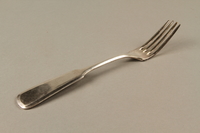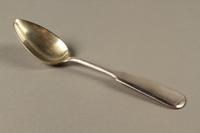Overview
- Description
- The collection documents the Holocaust-era experiences of Fruma Gulkowitz-Berger (pen name of Frances Berger) and Murray Berger, both of whom joined the Bielski partisans in Western Belorussia (Belarus). The collection includes identification papers and immigration documents of Fruma, Murray, and Murray’s brother Elliot; manuscripts of essays and poems by Fruma Gulkowitz-Berger along with clippings of her articles; and pre-war and post-war photographs.
Biographical materials include identification cards issued by the Red Cross, DP identification cards, and Italian identification documents. The immigration documents include a small amount of immigration paperwork and naturalization certificates. Also included are lists of family members who perished in the Holocaust.
Writings include handwritten and photocopies of typed manuscripts of Fruma Gulkowitz-Berger. Her writings include essays and poems about the Holocaust, both in English and Yiddish. Also included are clippings of her writings from newspapers and other sources. Folder 2.9 contains writings of Murray Berger, and folder 2.15 contains writings of Y. Shmulevitsh.
Photographs include pre-war depictions of the Gulkowitz and Shmulewicz families, the Kibbutz Turda displaced persons camp in Romania, displaced persons camps in Italy, and memorials to the Jews of Korelitz (Korelichi, Belarus) and Nowogródek (Navahrudak, Belarus), Poland. - Date
-
inclusive:
1930-1990
undated:
- Credit Line
- United States Holocaust Memorial Museum Collection, Gift of Ralph S. Berger and Albert S. Berger
United States Holocaust Memorial Museum Collection, Gift of Albert S. Berger and Ralph S. Berger - Collection Creator
- Fruma Gulkowitz-Berger
Murray Berger - Biography
-
Fruma Gulkowitz-Berger (born Fruma Gulkowitz, also known as Frances Berger, 1918-1995) was born on 18 May 1918 in Lublin, Poland to Rochel (née Krynicky or Kriniki, 1885-1941) and Shlomo (1882-1942) Gulkowitz. She had three sisters, Feigel (1915-1942), Grunia (1909-1942), and Brina (1922-1942), and one brother, Ben-Zion. When Fruma was a child her family moved to Korelitz (Korelichi, Belarus), Poland. Her brother Ben-Zion married a woman named Judes and they had a daughter, Chaya (1939-1942). Her sister Grunia had a daughter, Miriam Weintraub (1936-1942).
After the outbreak of World War II, the Russians occupied Korelitz. By July 1941 the town was occupied by the German army. Fruma’s family, along with the rest of the Jews in town, were sent to the Korelitz ghetto. Fruma’s mother, Rochel, was killed in the ghetto on 27 December 1941 after being severely beaten by the police. In May 1942 the ghetto was closed and they were deported to the nearby Nowogródek ghetto (Navahrudak, Belarus). In August 1942, Fruma and her sister-in-law Judes hid in the ghetto outhouse with two other women. Around the same time, her brother Ben-Zion escaped with seven others including Murray Berger and joined the Bielski partisans, let by Tuvia Bielski. Several weeks after joining, Ben-Zion returned to the ghetto and rescued Fruma and Judes. They both then joined the partisans as well, participating in acts of sabotage and other forms of resistance.
After liberation by the Red Army, Fruma and Murray, whom she met while with the partisans, went to the Kibbutz Turda displaced persons camp in Romania in early 1945. They left in May 1945 and went first to Austria and then the Kibbutz Anzio DP camp in Italy. Fruma and Murray married while in Italy, and immigrated to the United States in 1947. They settled in New York and had two sons, Albert and Ralph.
Fruma’s father, sisters, and niece all perished on 7 August 1942 in the Nowogródek ghetto.
Murray Berger (born Mordechai Shmulewicz, 1912-1999) was born on 12 February 1912 in Wsielub, Belorussia (Vselyub, Belarus) to Abraham (born Abraham Berger, 1875-1941) and Sara (d. 1941) Shmulewicz. He had four brothers, Elliot (born Elia Shmulewicz, 1910-1998), Harry, Zemach (1902-1941), and Issak (1906-1942); and two sisters, Bluma (Bluma Bussel, 1908-1942) and Rachel (Rachel Fuks, 1904-1941). Murray’s father Abraham worked as a butcher, and changed the family name from Berger to Shmulewicz to avoid military service. Murray changed his last name back to Berger after immigrating to the United States. Before the war, Murray was studying to become a rabbi and lived in Vilna (Vilnius, Lithuania) for several year before moving back to Wsielub to care for his sick mother.
Once the war began, the Russians occupied Wsielub and anti-Semetic activities increased. On 25 December 1940 the police approached Murray’s house to arrest him but he managed to escape and flee Wsielub. He went to Nowogródek where he remained with his cousin Alter Nochimovski. On 5 December 1941 the Germans began preparing for mass executions by having large pits dug by slave Jewish labor. Murray escaped into the forest where he remained for the duration of the winter, surviving in part due to acts of kindness from local farmers. He eventually went back to the Nowogródek ghetto not knowing where else to go. He managed to sneak into the ghetto and remained there until August 1942 when he escaped the ghetto with seven other men in order to join the Bielski partisans. He met his future wife, Fruma Gulkowitz, while with the partisans.
Murray lost 126 members of his family in the Holocaust. His brother Harry immigrated to the United States prior to Murray’s birth. His brother Elliot was drafted into the Russian army where he was wounded. His wife was in the Nowogródek ghetto when she gave birth. The next day the Nazis killed her and their baby. Murray was able to get back in contact with Elliot after he and Fruma returned to Nowogródek after liberation. Elliot received leave to visit them and decided not to return to the army. He travelled with them to the DP camps and to the United States.
Physical Details
- Genre/Form
- Photographs. Poems. Memoirs.
- Extent
-
1 box
- System of Arrangement
- The collection is arranged as three series: Series 1. Biographical, 1945-1982; Series 2. Writings, 1968-1990 and undated; Series 3. Photographs, 1930-1948 and undated
Rights & Restrictions
- Conditions on Access
- There are no known restrictions on access to this material.
- Conditions on Use
- Material(s) in this collection may be protected by copyright and/or related rights. You do not require further permission from the Museum to use this material. The user is solely responsible for making a determination as to if and how the material may be used.
Keywords & Subjects
- Topical Term
- World War, 1939-1945--Jewish resistance--Personal narratives. Jewish families--Belarus--Navahrudak. Jewish ghettos--Belarus--Navahrudak. Guerillas--Belarus. Jewish women authors.
- Geographic Name
- Korelichi (Belarus) Navahrudak (Belarus) Rome (Italy) Romania. Usali︠u︡b (Belarus)
- Personal Name
- Gulkowitz-Berger, Fruma, 1918-1995. Berger, Murray, 1912-1999. Gulkowitz, Ben-Zion. Berger, Elliot, 1910-1998. Bielski, Tuvia.
- Corporate Name
- Bielski partisans (Resistance group)
Administrative Notes
- Holder of Originals
-
United States Holocaust Memorial Museum
- Legal Status
- Permanent Collection
- Provenance
- The collection was donated to the United States Holocaust Memorial Museum by Ralph S. Berger in 1997. He and brother Albert S. donated an accretion in 2017. Both collections, 1997.A.0253 and 2017.262.1 have been unified under the new accession number of 2017.262.5.
- Primary Number
- 2017.262.5
- Record last modified:
- 2023-08-23 09:06:12
- This page:
- https://collections.ushmm.org/search/catalog/irn563805
Additional Resources
Download & Licensing
In-Person Research
- Available for Research
- Plan a Research Visit
-
Request in Shapell Center Reading Room
Bowie, MD
Contact Us
Also in Fruma Gulkowitz Berger collection
The collection consists of a fork, spoon, originals and photocopies of poems and prose writings, a composition book of poetry, newspaper clippings, photocopies of articles, and photographs relating to the experiences of Frances (Fruma) Gulkowitz Berger, Murray Berger (originally Mordechai Shmulewicz), and Elliot Berger (originally Elia Shmulewicz) during the Holocaust in Poland where they were interned in ghettos and then escaped and joined the Bielski partisan brigade, as well as their experiences in the postwar period.
Date: 1930-1990

Fork
Object
Fork saved by Frances (Fruma) Gulkowitz from her home in Korelitz, Poland (Belarus). Fruma and her family where interned by the Germans in the Korelitz ghetto in July 1941. Her mother was killed by the police. In May 1942, Fruma and her family were sent to Novogrudek (now Navahrudak, Belarus). Around August 1942, Fruma's brother Ben-Zion escaped with Murray Berger and others and joined the Bielski partisans. He later returned to the ghetto and rescued Fruma and Judes who also joined the partisans. After liberation by the Red Army, Fruma and Murray went to the Kibbutz Turda displaced persons camp in Romania and eventually to Kibbutz Anzio DP camp in Italy. Fruma and Murray married and emigrated to the United States in 1947. Fruma’s father, sisters, and niece perished in Nowogródek ghetto.

Spoon
Object
Spoon saved by Frances (Fruma) Gulkowitz from her home in Korelitz, Poland (Belarus). Fruma and her family where interned by the Germans in the Korelitz ghetto in July 1941. Her mother was killed by the police. In May 1942, Fruma and her family were sent to Novogrudek (now Navahrudak, Belarus). Around August 1942, Fruma's brother Ben-Zion escaped with Murray Berger and others and joined the Bielski partisans. He later returned to the ghetto and rescued Fruma and Judes who also joined the partisans. After liberation by the Red Army, Fruma and Murray went to the Kibbutz Turda displaced persons camp in Romania and eventually to Kibbutz Anzio DP camp in Italy. Fruma and Murray married and emigrated to the United States in 1947. Fruma’s father, sisters, and niece perished in Nowogródek ghetto.

Oral history interview with Murray Berger
Oral History



